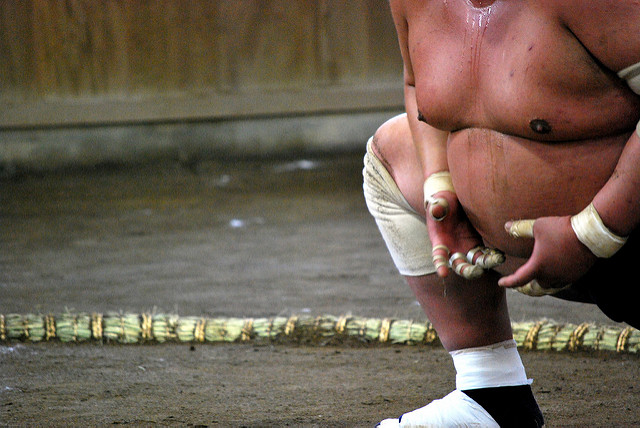May 29, 2018
Getting Up Close and Personal at Nagoya’s Sumo Stables
The sumo season centers around six fifteen-day major competitions, or ‘honbasho’, throughout the year, with three events held in Tokyo in January, May and September, one in March in Osaka, one in Fukuoka in November, and July sees the Nagoya Basho.
The honbasho – literally ‘real tournament’ – are of great importance to the sumo world as they are the only events at which wrestlers, or ‘rikishi’ can be promoted and demoted in the rankings. As such these bouts are witness to intense competition.
Perhaps the most grueling of these events is the Nagoya Basho, being as it is held in one of the country’s most humid of cities at the muggiest time of the year; something that cannot be particularly enjoyable for guys who weigh in at an average of 148 kg (326 lbs), even of they are wearing nothing more than ‘mawashi’ loincloths. To acclimatize to the conditions, two weeks prior to the event the rikishi leave their Tokyo homes and decamp to the training centers – known as stable or ‘heya’ in Japanese – of Aichi to prepare for the extreme heat and competition.
The great thing about this is that for the fortnight that they are in town their ‘asageiko’ morning training sessions are open to the public, giving us locals an amazing chance to watch them in action as they perfect their moves and improve before the big event.
Below is a selection of some of the most prestigious stables and where you can find them. For the entire list of ‘sumo beya’ in Nagoya, check out the always fantastic kikuko-nagoya.com website’s list here.
Most morning sessions are held between 6:30 and 9:30 or 10:00 depending on the stable. Please note, some stables do not open for training. At the time of publication the below stables were still advertised as allowing visitors, however this is subject to change, so it is advisable to contact the stable in advance or check their website.
Prestigious stables with morning practice
Isenoumi Stable
The Isenoumi name is one of the most traditional in sumo.
- Where: Zenko-ji Betsuin, 1-377, Nakaotai, Nishi-ku (map)
- Website: isenoumi.org
Izutsu Stable
The Izutsu stable has been in the same family on and off since the Meiji era. It is the home to the Mongolian ‘yokozuna’ (the top ranking of sumo wrestlers, of which currently there are only three) Kakuryū Rikisaburō.
- Where: Kenko-in, 35-2, OgawaShiota, Higashiura-cho, Chita-gun (map)
- Website: izutsurm.la.coocan.jp
Kasugano Stable
Currently one of the most successful stables, Kasugano stable has been active since the Meiji era.
- Where: Hachimansha Shrine, 2-31-1, Kashiwai-cho, Kasugai City (map)
- Website: facebook.com/kasuganobeya
Miyagino Stable
Miyagino Beya is home to Hakuhoō Shō, arguably most successful rikishi of all time. The Mongolian holds the record of most top division championships, most wins in the top division and most career wins. He has been ranked as a yokozuna for a record 64 tournaments.
- Where: Josen-ji, 9 Kaminaka-machi, Narumi-cho, Midori-ku (map)
- Website: sumo.or.jp
Tagonoura Stable
Tagonoura Stable is home to Kisenosato Yutaka, who made headlines in 2017 for becoming the first rikishi of Japanese decent to be promoted to the rank of yokozuna since since Wakanohana in 1998.
- Where: Daiyu-in, 1704, Kanihara, Nagakute-cho (map)
- Website: tagonoura.jp
Takasago Stable
Incorporated in 1878, Takasago Beya is the second oldest, and perhaps most successful, stable in the history of the organized sport.
- Where: Ryusho-in,Sunari-monyashiki-kami, Kanie-cho, Ama-gun (map)
- Website: biglobe.ne.jp
Tomozuna Stable
With a long and prestigious history, the Tomozuna Beya was able to absorb many high profile wrestlers from the famous Oshima stable when it closed in 2012.
- Where: Ganjo-ji, Yakushi-do, 8, Takasuka-cho, Nakamura-ku (map)
- Website: tomozuna-beya.jp
Nagoya Summer Basho
“The July Tournament,” or the Nagoya Grand Sumo Tournament takes place every July at the Aichi Prefectural Gymnasium near Nagoya Castle and lasts for 15 days.
Advanced ticket purchases can be made by telephone, online, at the venue (10:00 to 17:00; closed weekends and public holidays), or through a variety of other ticket agents outlined on the Nihon Sumo Kyokai Official Grand Sumo website. Tickets go on sale from May 21.
- Where: Aichi Prefectural Gymnasium, Nagoya, Naka Ward, Ninomaru, 1−1 (map)
- When: July 9 to 22, 2018
- Website: sumo.or.jp
- Tel: 052-971-2516
For more information on the Nagoya Basho, and sumo in general, check out a previous JIS article here.
By Mark Guthrie
Photo: by funkgirldeluxe (CC BY-SA 2.0) via flickr.com
Photo: by Michael Whalen (CC BY-SA 2.0) via flickr.com
Photo: by jpellgen (@1179_jp) (CC BY-SA 2.0) via flickr.com





About the author